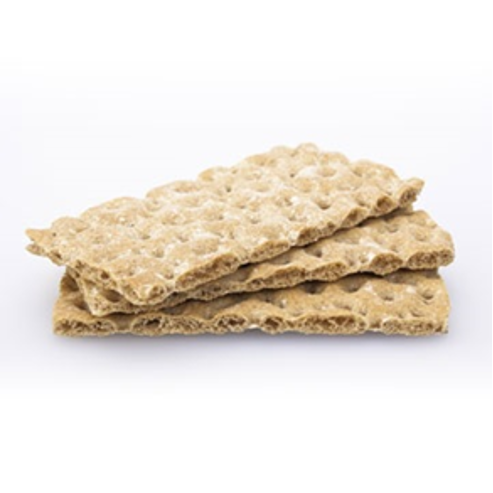
Crispbread
The most delicious bread replacement!
The crispbread recipe, invented about 500 years ago traditionally consists mainly of rye flour, with the addition of spelt flour, salt and water. Finland and Sweden have long traditions of crispbread consumption. The origin of crispbread came from the earlier spisbröd (stovebread) which was a similar but thicker kind of bread.
These breads were baked from at least the 6th century in central Sweden.
They were usually hung above the stove to be dried.
A wide range available to suit all tastes!
Today, much crispbread contains wheat flour, spices, and grains, and is often leavened with yeast or sourdough. In the case of unleavened crispbread, bubbles are introduced into the dough mechanically. Traditionally, this was done by mixing snow or powdered ice into the dough (so called “ice knacke”), which then evaporated during baking. Today, the dough, which must contain a large amount of water, is cooled and mixed until bubbly.
Biscuit International offers the complete range of crispbread with different varieties including:
- Classic crispbread “ice bread” unleavened with different recipes such as rye and sesame
- Organic crispbread “ice bread” unleavened with different recipes such as rye, sesame, quinoa or linseed
- Regular “leavened crispbread” with different recipes such as rye, rye/sesame, gold/brown, wheat/sesame or whole wheat
- Organic “leavened crispbread” with different recipes such as rye, sesame, quinoa or multi-grain

Our crispsbread range:
Market and consumer insights
The crispbread market is very big, with more than €620m of sales in 2022 across the ten EU countries we track. Germany and Sweden have the highest consumption of crispbread.
Crispbread is increasingly common in Central and Northern Europe.
In Southern Europe, crackers and toasted bread are frequently consumed as alternatives. In Europe, crispbreads are usually eaten at mealtimes, although increasingly they are also a snacking opportunity.
In general, bread replacements, including crispbread, are mainly consumed during breakfast.
Penetration of this product is highest in Sweden: 92 per cent of Swedish households consume crispbread, vs. 53 per cent in Germany and 17 per cent in France.


Latest innovation
Snacking is central to product development in the global food and drink market, but innovation activity in crispbread has so far been more focused on health. Almost 40% of global launches in this category featured wholegrain claims, whilst a third of new product development carried “high in fibre” descriptions. “Source of fibre”, wholegrain and organic are the most frequent positioning within the crispbread category.
Nonetheless, convenience-driven and snack-friendly innovation is gaining more steam in the crispbread category. The events of the last few years have seen a shift in how and where consumers consume food and drink, in part driven by an increase in home working.
Anticipating this, Biscuit International has introduced portion-packed crispbread, available in portions with five slices packed in a recyclable folded carton. The folded carton contains from three to five portion packs. This packaging format fits perfectly with “on the go” and out-of-home consumption trends, as well as contributing to a reduction in food waste due to it preserving freshness for longer.



